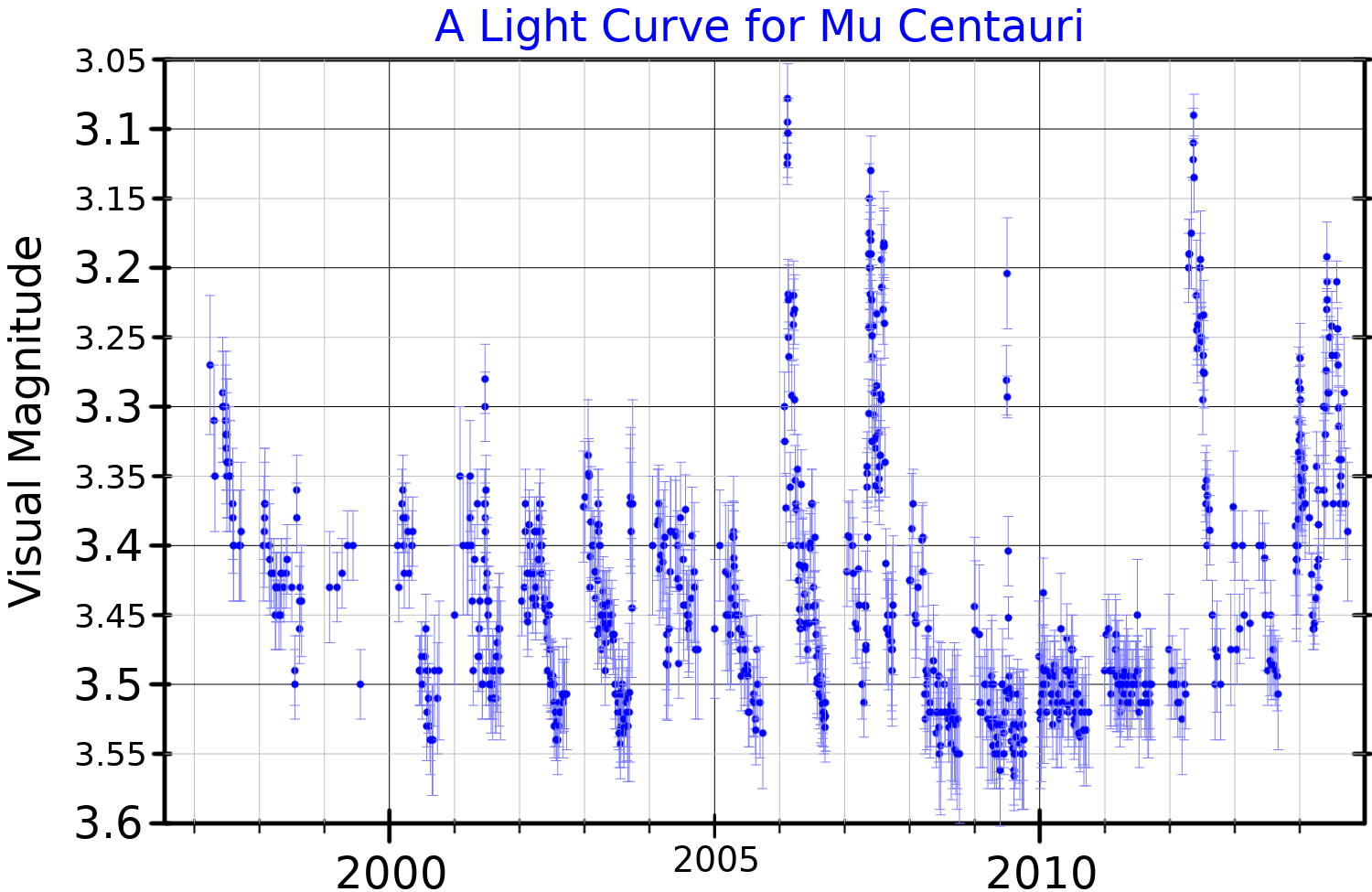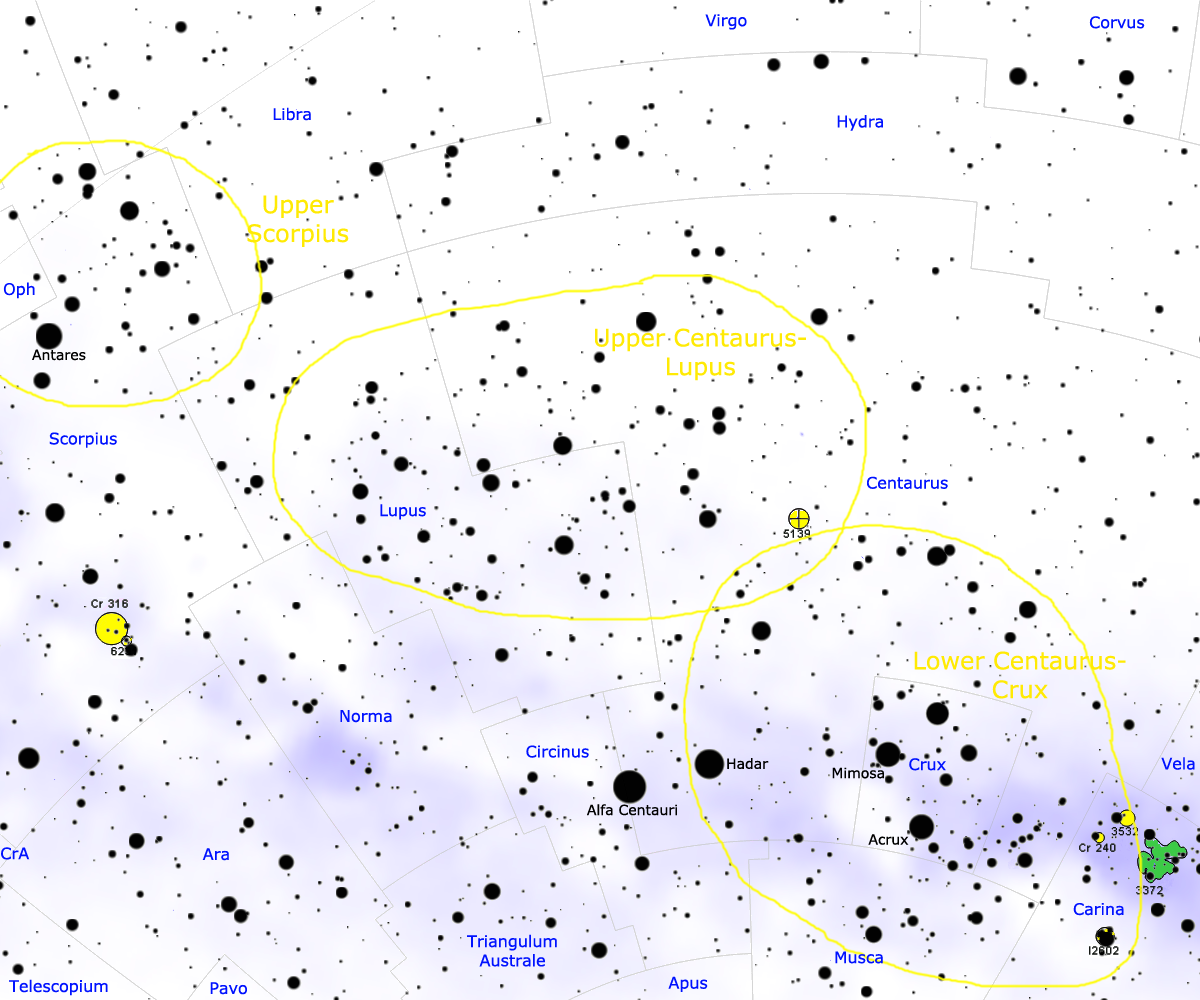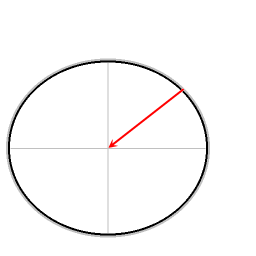|
Mu Centauri
Mu Centauri, Latinized from μ Centauri, is a third-magnitude star in the southern constellation of Centaurus. With the stars ν and φ Centauri, it marks what has been traditionally portrayed as "''dextro Latere''" (the right side) of the CentauThe apparent visual magnitude of this star is 3.42, making it one of the brighter members of the constellation. The distance to this star can be estimated directly using parallax measurements, which yield a value of roughly 510 light years (155 parsecs) from Earth. The spectrum of Mu Centauri is considered to be a standard for a B2 Be star with the stellar classification of B2V:e. The 'e' suffix is used to mark the presence of emission lines, caused by a circumstellar disk of hot gas that was formed from material ejected from the star. Mu Centauri is a pulsating variable star that has multiple non-radial cycles with a primary period of 0.503 days. Three other pulsation cycles have a similar period, while two hav ... [...More Info...] [...Related Items...] OR: [Wikipedia] [Google] [Baidu] |
J2000
In astronomy, an epoch or reference epoch is a instant, moment in time used as a reference point for some time-varying astronomical quantity. It is useful for the celestial coordinates or orbital elements of a Astronomical object, celestial body, as they are subject to Perturbation (astronomy), perturbations and vary with time. These time-varying astronomical quantities might include, for example, the mean longitude or mean anomaly of a body, the node of its orbit relative to a reference plane, the direction of the apogee or Perihelion and aphelion, aphelion of its orbit, or the size of the major axis of its orbit. The main use of astronomical quantities specified in this way is to calculate other relevant parameters of motion, in order to predict future positions and velocities. The applied tools of the disciplines of celestial mechanics or its subfield orbital mechanics (for predicting orbital paths and positions for bodies in motion under the gravitational effects of other bodi ... [...More Info...] [...Related Items...] OR: [Wikipedia] [Google] [Baidu] |
Stellar Classification
In astronomy, stellar classification is the classification of stars based on their stellar spectrum, spectral characteristics. Electromagnetic radiation from the star is analyzed by splitting it with a Prism (optics), prism or diffraction grating into a spectrum exhibiting the Continuum (spectrum), rainbow of colors interspersed with spectral lines. Each line indicates a particular chemical element or molecule, with the line strength indicating the abundance of that element. The strengths of the different spectral lines vary mainly due to the temperature of the photosphere, although in some cases there are true abundance differences. The ''spectral class'' of a star is a short code primarily summarizing the ionization state, giving an objective measure of the photosphere's temperature. Most stars are currently classified under the Morgan–Keenan (MK) system using the letters ''O'', ''B'', ''A'', ''F'', ''G'', ''K'', and ''M'', a sequence from the hottest (''O'' type) to the coo ... [...More Info...] [...Related Items...] OR: [Wikipedia] [Google] [Baidu] |
International Astronomical Union
The International Astronomical Union (IAU; french: link=yes, Union astronomique internationale, UAI) is a nongovernmental organisation with the objective of advancing astronomy in all aspects, including promoting astronomical research, outreach, education, and development through global cooperation. It was founded in 1919 and is based in Paris, France. The IAU is composed of individual members, who include both professional astronomers and junior scientists, and national members, such as professional associations, national societies, or academic institutions. Individual members are organised into divisions, committees, and working groups centered on particular subdisciplines, subjects, or initiatives. As of 2018, the Union had over 13,700 individual members, spanning 90 countries, and 82 national members. Among the key activities of the IAU is serving as a forum for scientific conferences. It sponsors nine annual symposia and holds a triannual General Assembly that sets policy ... [...More Info...] [...Related Items...] OR: [Wikipedia] [Google] [Baidu] |
Stellar Association
A stellar association is a very loose star cluster, looser than both open clusters and globular clusters. Stellar associations will normally contain from 10 to 100 or more stars. The stars share a common origin, but have become gravitationally unbound and are still moving together through space. Associations are primarily identified by their common movement vectors and ages. Identification by chemical composition is also used to factor in association memberships. Stellar associations were first discovered by the Soviet Armenian astronomer Victor Ambartsumian in 1947. The conventional name for an association uses the names or abbreviations of the constellation (or constellations) in which they are located; the association type, and, sometimes, a numerical identifier. Types Victor Ambartsumian first categorized stellar associations into two groups, OB and T, based on the properties of their stars. A third category, R, was later suggested by Sidney van den Bergh for associations th ... [...More Info...] [...Related Items...] OR: [Wikipedia] [Google] [Baidu] |
Scorpius–Centaurus Association
The Scorpius–Centaurus association (sometimes called Sco–Cen or Sco OB2) is the nearest OB association to the Sun. This stellar association is composed of three subgroups (Upper Scorpius, Upper Centaurus–Lupus, and Lower Centaurus–Crux) and its distance is about 130 parsecs or 420 light-years. Using improved Hipparcos data, Rizzuto and colleagues analysed nearby stars more closely, bringing the number of known members to 436. They doubt the need to add a subclassification because they found a more continuous spread of stars. The Sco–Cen subgroups range in age from 11 million years (Upper Scorpius) to roughly 15 million years (Upper Centaurus–Lupus and Lower Centaurus–Crux). Many of the bright stars in the constellations Scorpius, Lupus, Centaurus, and Crux are members of the Sco–Cen association, including Antares (the most massive member of Upper Scorpius), and most of the stars in the Southern Cross. Hundreds of stars have been identified as members of Sco-Cen, ... [...More Info...] [...Related Items...] OR: [Wikipedia] [Google] [Baidu] |
Proper Motion
Proper motion is the astrometric measure of the observed changes in the apparent places of stars or other celestial objects in the sky, as seen from the center of mass of the Solar System, compared to the abstract background of the more distant stars. The components for proper motion in the equatorial coordinate system (of a given epoch, often J2000.0) are given in the direction of right ascension (''μ''α) and of declination (''μ''δ). Their combined value is computed as the ''total proper motion'' (''μ''). It has dimensions of angle per time, typically arcseconds per year or milliarcseconds per year. Knowledge of the proper motion, distance, and radial velocity allows calculations of an object's motion from our star system's frame of reference and its motion from the galactic frame of reference – that is motion in respect to the Sun, and by coordinate transformation, that in respect to the Milky Way. Introduction Over the course of centuries, stars appear t ... [...More Info...] [...Related Items...] OR: [Wikipedia] [Google] [Baidu] |
Effective Temperature
The effective temperature of a body such as a star or planet is the temperature of a black body that would emit the same total amount of electromagnetic radiation. Effective temperature is often used as an estimate of a body's surface temperature when the body's emissivity curve (as a function of wavelength) is not known. When the star's or planet's net emissivity in the relevant wavelength band is less than unity (less than that of a black body), the actual temperature of the body will be higher than the effective temperature. The net emissivity may be low due to surface or atmospheric properties, including greenhouse effect. Star The effective temperature of a star is the temperature of a black body with the same luminosity per ''surface area'' () as the star and is defined according to the Stefan–Boltzmann law . Notice that the total (bolometric) luminosity of a star is then , where is the stellar radius. The definition of the stellar radius is obviously not straightf ... [...More Info...] [...Related Items...] OR: [Wikipedia] [Google] [Baidu] |
Hydrogen Burning
Stellar nucleosynthesis is the creation (nucleosynthesis) of chemical elements by nuclear fusion reactions within stars. Stellar nucleosynthesis has occurred since the original creation of hydrogen, helium and lithium during the Big Bang. As a predictive theory, it yields accurate estimates of the observed abundances of the elements. It explains why the observed abundances of elements change over time and why some elements and their isotopes are much more abundant than others. The theory was initially proposed by Fred Hoyle in 1946, who later refined it in 1954. Further advances were made, especially to nucleosynthesis by neutron capture of the elements heavier than iron, by Margaret and Geoffrey Burbidge, William Alfred Fowler and Hoyle in their famous 1957 B2FH paper, which became one of the most heavily cited papers in astrophysics history. Stars evolve because of changes in their composition (the abundance of their constituent elements) over their lifespans, first by b ... [...More Info...] [...Related Items...] OR: [Wikipedia] [Google] [Baidu] |
Main Sequence
In astronomy, the main sequence is a continuous and distinctive band of stars that appears on plots of stellar color versus brightness. These color-magnitude plots are known as Hertzsprung–Russell diagrams after their co-developers, Ejnar Hertzsprung and Henry Norris Russell. Stars on this band are known as main-sequence stars or dwarf stars. These are the most numerous true stars in the universe and include the Sun. After condensation and ignition of a star, it generates thermal energy in its dense core region through nuclear fusion of hydrogen into helium. During this stage of the star's lifetime, it is located on the main sequence at a position determined primarily by its mass but also based on its chemical composition and age. The cores of main-sequence stars are in hydrostatic equilibrium, where outward thermal pressure from the hot core is balanced by the inward pressure of gravitational collapse from the overlying layers. The strong dependence of the rate of energy ge ... [...More Info...] [...Related Items...] OR: [Wikipedia] [Google] [Baidu] |
Oblate Spheroid
A spheroid, also known as an ellipsoid of revolution or rotational ellipsoid, is a quadric surface obtained by rotating an ellipse about one of its principal axes; in other words, an ellipsoid with two equal semi-diameters. A spheroid has circular symmetry. If the ellipse is rotated about its major axis, the result is a ''prolate spheroid'', elongated like a rugby ball. The American football is similar but has a pointier end than a spheroid could. If the ellipse is rotated about its minor axis, the result is an ''oblate spheroid'', flattened like a lentil or a plain M&M. If the generating ellipse is a circle, the result is a sphere. Due to the combined effects of gravity and rotation, the figure of the Earth (and of all planets) is not quite a sphere, but instead is slightly flattened in the direction of its axis of rotation. For that reason, in cartography and geodesy the Earth is often approximated by an oblate spheroid, known as the reference ellipsoid, instead of a spher ... [...More Info...] [...Related Items...] OR: [Wikipedia] [Google] [Baidu] |
Equatorial Bulge
An equatorial bulge is a difference between the equatorial and polar diameters of a planet, due to the centrifugal force exerted by the rotation about the body's axis. A rotating body tends to form an oblate spheroid rather than a sphere. On Earth The Earth has a rather slight equatorial bulge: it is about wider at the equator than pole-to-pole, a difference which is about 1/298 of the equatorial diameter. If the Earth were scaled down to a globe with diameter of 1 meter at the equator, that difference would be only 3 millimeters. While too small to notice visually, that difference is still more than twice the largest deviations of the actual surface from the ellipsoid, including the tallest mountains and deepest oceanic trenches. The rotation of the earth also affects the sea level, the imaginary surface that is used to measure altitudes from. This surface coincides with the mean water surface level in oceans, and is extrapolated over land by taking into account the local g ... [...More Info...] [...Related Items...] OR: [Wikipedia] [Google] [Baidu] |
Azimuth
An azimuth (; from ar, اَلسُّمُوت, as-sumūt, the directions) is an angular measurement in a spherical coordinate system. More specifically, it is the horizontal angle from a cardinal direction, most commonly north. Mathematically, the relative position vector from an observer (origin) to a point of interest is projected perpendicularly onto a reference plane (the horizontal plane); the angle between the projected vector and a reference vector on the reference plane is called the azimuth. When used as a celestial coordinate, the azimuth is the horizontal direction of a star or other astronomical object in the sky. The star is the point of interest, the reference plane is the local area (e.g. a circular area with a 5 km radius at sea level) around an observer on Earth's surface, and the reference vector points to true north. The azimuth is the angle between the north vector and the star's vector on the horizontal plane. Azimuth is usually measured in d ... [...More Info...] [...Related Items...] OR: [Wikipedia] [Google] [Baidu] |

.jpg)



